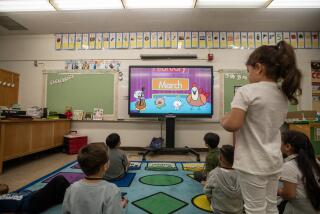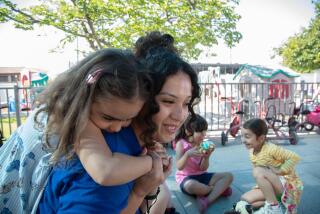Ends 3rd Semester in Woodland Hills : Infant Plays Part of Teacher for Elementary School Project
- Share via
Andrew Warren is the most popular kid at Woodlake Avenue Elementary School.
But don’t look for him to run for class president any time soon--he’s only 18 months old.
For more than a year, however, Andrew has been making periodic appearances at the school in Woodland Hills as part of an unusual early-childhood education project aimed at teaching students about human growth, nutrition and infant safety.
With wide-eyed students looking on, Andrew has grown from a helpless, cooing infant into a crawling tot and, finally, an active toddler. On Thursday, the blond-haired boy wrapped up his third semester in the classroom by discussing books and tackling a computerized math problem with a group of second-graders.
“Choo-choo,” Andrew said, thumbing through a pop-up book about trains as he sat in front of the class. At the classroom’s computer terminal, Andrew banged randomly on the keys as he took a gamelike test of subtraction skills.
“He’s cute. He got most of the questions right,” 7-year-old Michael Roberts said. Then, lowering his voice so Andrew would not hear, Michael added, “They were lucky guesses.”
Start of Career
Andrew’s teaching career was launched a few months after his birth to Marjorie Warren, a former volunteer classroom aide from Woodland Hills. Woodlake Principal Don Foster noticed how children clustered around Andrew’s baby stroller when Warren came at the end of the school day to meet an older son and daughter attending the school.
“Andrew had charisma,” Foster recalled. “He enjoyed being around the older kids.”
Because child-molestation incidents were in the headlines at the time, Foster said he thought it would be a good idea to teach the students about baby care, using that to address the issue of respect for all defenseless children.
At his urging, Warren brought Andrew into the school during the spring of 1984 to illustrate talks to about 150 children in kindergarten through the second grade. During the first visits, she and the teachers covered topics such as how to safely carry and watch babies.
Resumed in Fall
The visits were resumed in the fall as the children advanced to the first through third grades. The appearances were scheduled at intervals of several months so that children would readily notice changes in Andrew’s size and development. They measured his head, charting the findings, and traced his hands to monitor their growth.
As he grew, so did the impromptu curriculum devised by Warren and the school’s teachers.
“He has a vocabulary of about 75 words already,” Warren told second-graders Thursday. “He understands everything. We have to spell words when we don’t want him to understand. But he already knows how to spell ‘cookie.’ ”
Pupils who have kept track of Andrew’s height and weight were given an update and Warren explained that Andrew no longer can sit for more than about three minutes before running off. “He’s very close to the Terrible Twos,” she said.
Comparing Notes
That drew scattered nods of agreement from children in the room who have younger siblings at home.
“Babies are such a terror. Mine takes my toys out and scatters them all over the room,” 8-year-old Larreen Moss said of her 20-month-old brother.
Alfred Castillo, 7, confided that his 18-month-old sister similarly “dumps all my toys out and makes a mess.”
Teacher Joanne Wolla said Andrew’s visits will teach the students lessons that will help them when they reach baby-sitting age.
Interest by State
Foster said Andrew’s appearances have attracted attention from state education officials in Sacramento and from professional curriculum writers coping with the issue of “latchkey” children of working and single parents.
He said he is also keeping a record of Andrew’s visits and related classroom discussions for Los Angeles school officials. Foster said he hopes similar programs are adopted in other schools.
Lorna Round, assistant district superintendent of elementary instruction, said Woodlake’s program is a one-of-a-kind experiment.
“It’s the kind of learning that makes a classroom come alive,” she said. “It involves reading, science, math, nutrition. The possibilities are endless. You can bring rabbits and chickens and so forth to class. I think a baby’s OK, too.”
More to Read
Sign up for Essential California
The most important California stories and recommendations in your inbox every morning.
You may occasionally receive promotional content from the Los Angeles Times.














